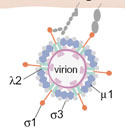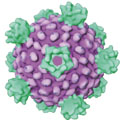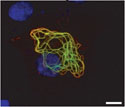Research Interests
-
Current Projects
|
| |
We use dsRNA viruses from the family Reoviridae, primarily reoviruses and rotaviruses, to study fundamental aspects of virus-cell interaction, structure-function relationships in virus particles, particle assembly, and viral pathogenesis. The following are some areas of current focus.
|
| |
Virus entry into cells
|
| |
 |
We are interested to define the biochemical and biophysical mechanisms by which non-enveloped viruses penetrate the cellular membrane barrier during entry. Since these viruses lack a lipid envelope that they can fuse with the cell's, mechanisms distinct from fusion are required. We are using new methods for in vitro assembly of the reovirus outer capsid from recombinant proteins to analyze mutations in these proteins that affect different steps in the penetration pathway. (Jané-Valbuena et al., 1999; Chandran et al., 2000; Chandran et al., 2001) Recently determined crystal structures for 2 of the 3 outer capsid proteins (obtained through our collaboration with Dr. Stephen C. Harrison) (Olland et al., 2001; Liemann et al., 2002) are greatly aiding these efforts.
|
| |
Synthesis, processing, and transport of viral RNA
|
| |
 |
The reovirus inner capsid particle, or core, represents a biochemically defined system for RNA-dependent RNA transcription, RNA 5' capping, and mRNA transport. Though much simpler than the related machinery of cells, this system is providing new insights into the structural and dynamic aspects of these basic processes. We are using a variety of methods to identify the functional roles of the different inner capsid proteins and the precise arrangements of them and their RNA templates and products within the core. Recently determined crystal structures for the reovirus RNA polymerase and three of the four other core proteins (obtained again through collaboration with Dr. Harrison) (Reinisch et al., 2000; Tao et al., in preparation) are crucial for these efforts.
|
| |
Virus assembly within cells
|
| |
 |
The volume of a cell is large compared to the small portion used by most viruses for their assembly. Moreover, the cell is highly compartmentalized with regard to different functions that viruses may need. We are interested to define specific elements of cellular organization that viruses exploit to benefit their own replication. A role for cellular microtubules in reovirus assembly was reported in some early literature but not reevaluated with modern techniques until our recent work (Parker et al., 2002). We are now characterizing important interactions among microtubules and other cellular and viral components involved in reovirus assembly within cells.
|
| |
Different approaches are used in our lab as the questions dictate, but biochemical, molecular, and genetic approaches predominate. Collaborations with structural biologists are embraced in order to extend our characterizations to higher levels of mechanistic resolution. Cell biological approaches are gaining in importance for several areas of our work. |
-
|
|